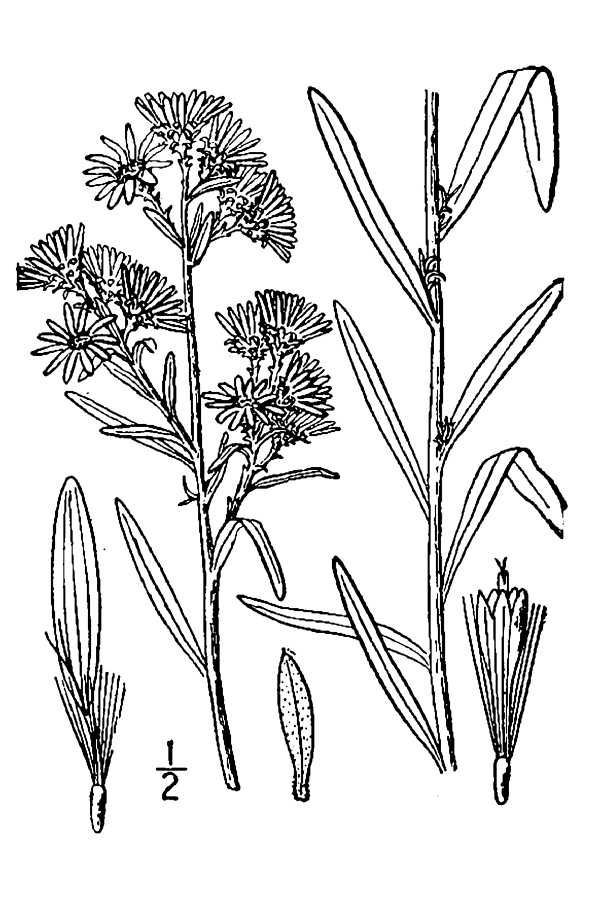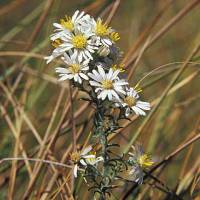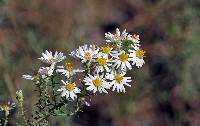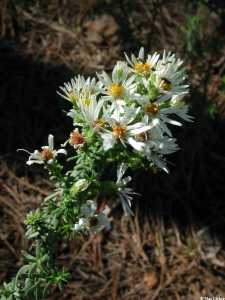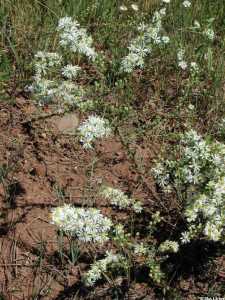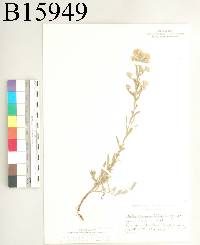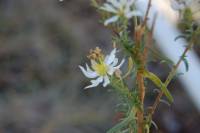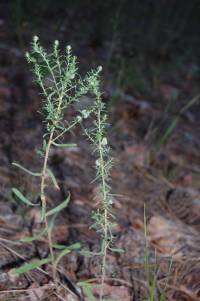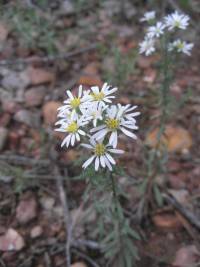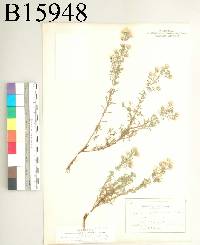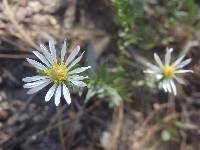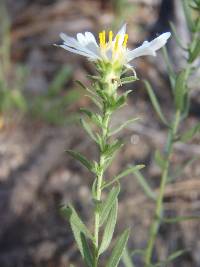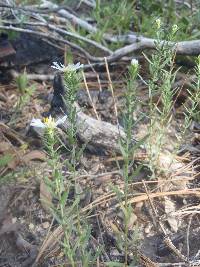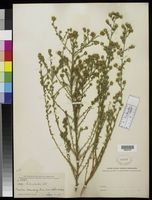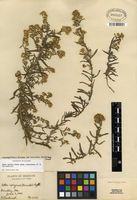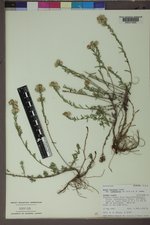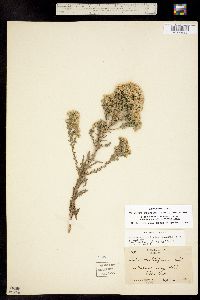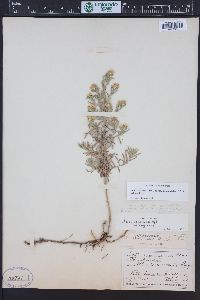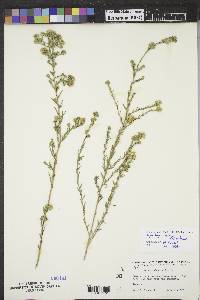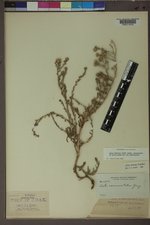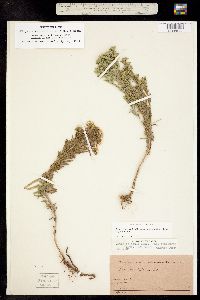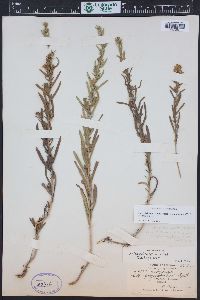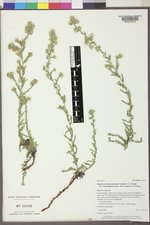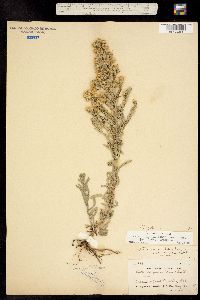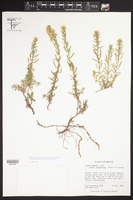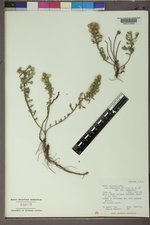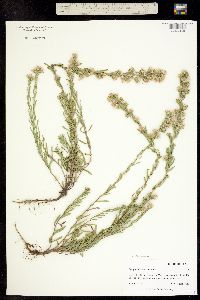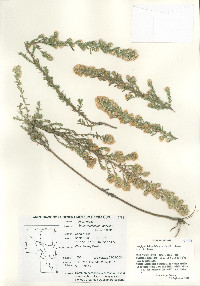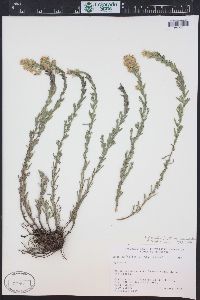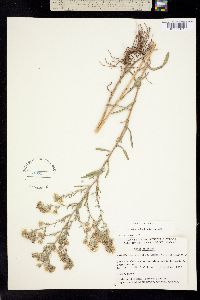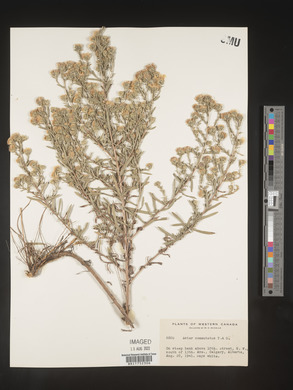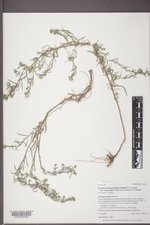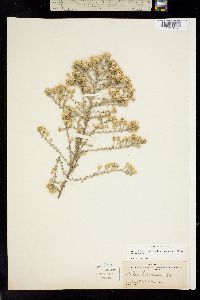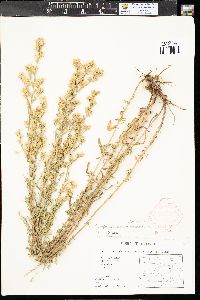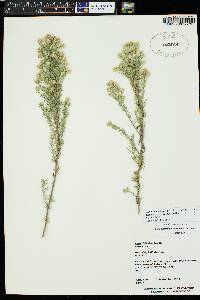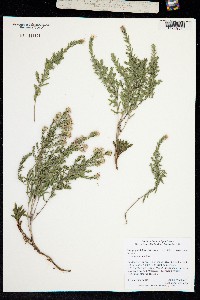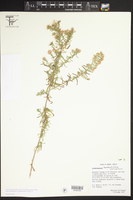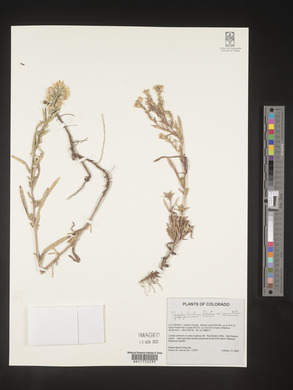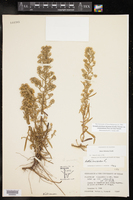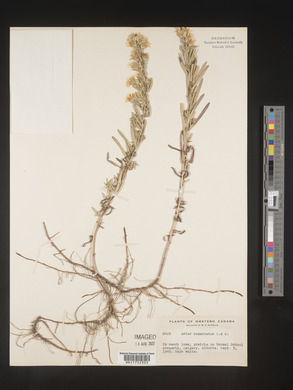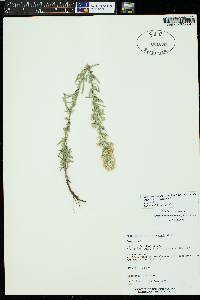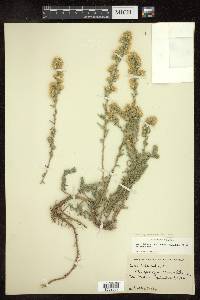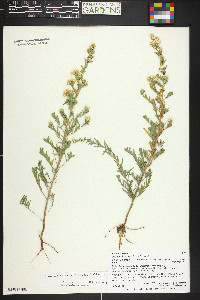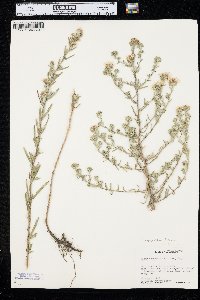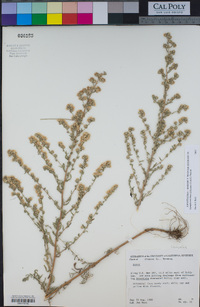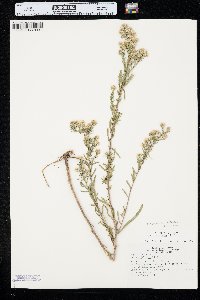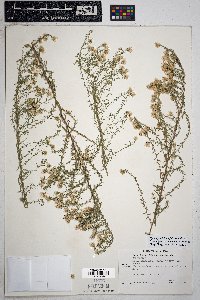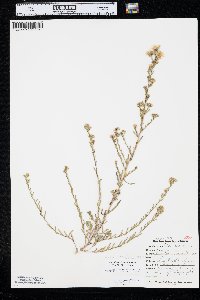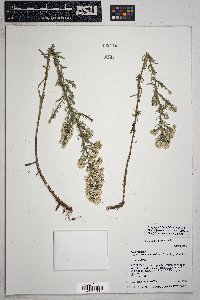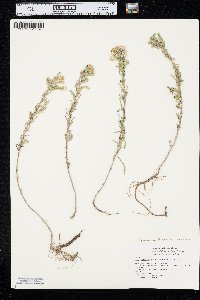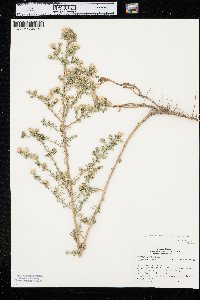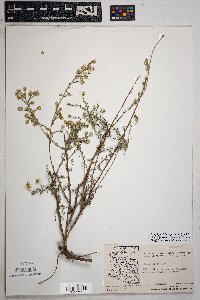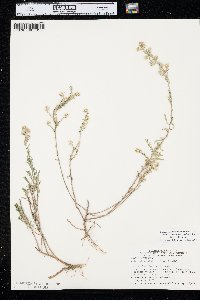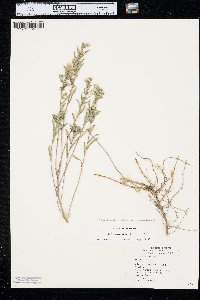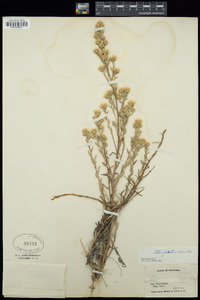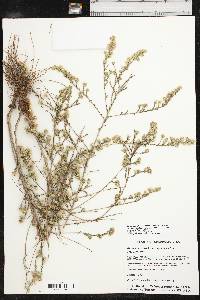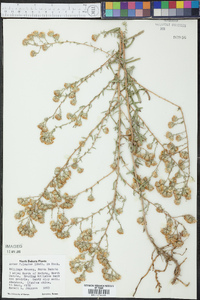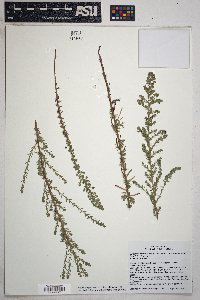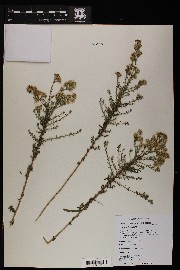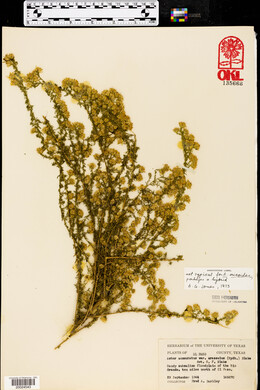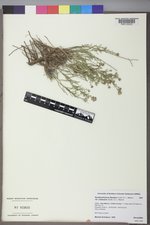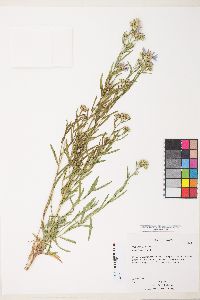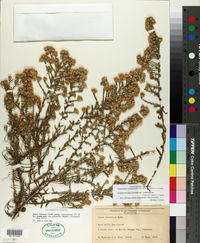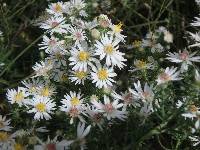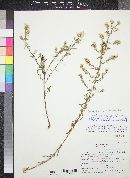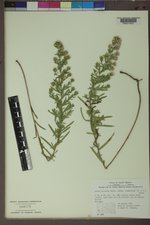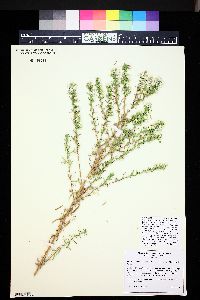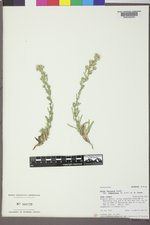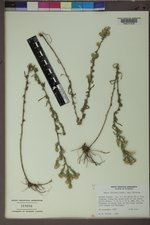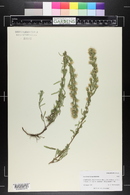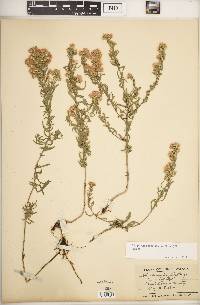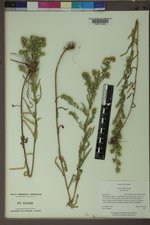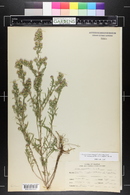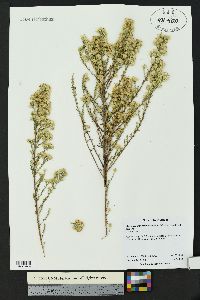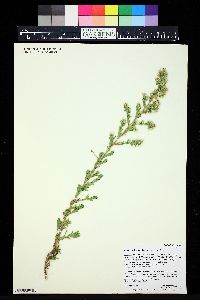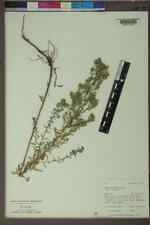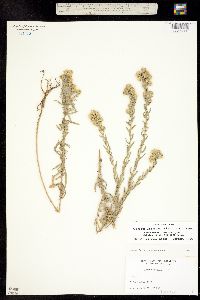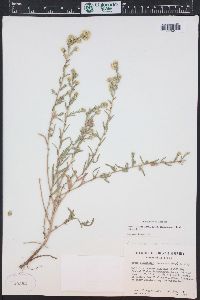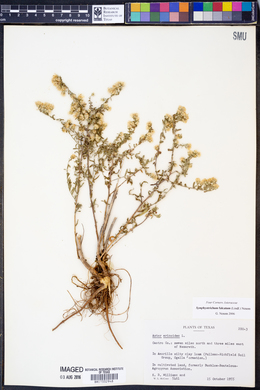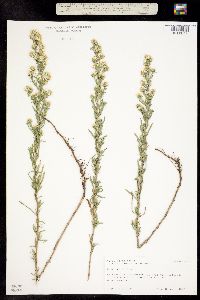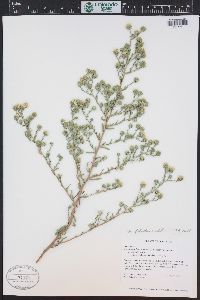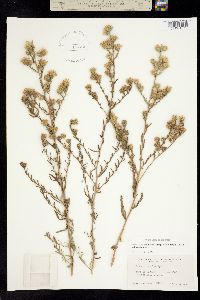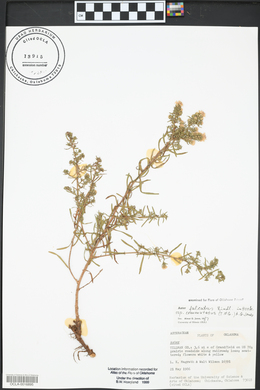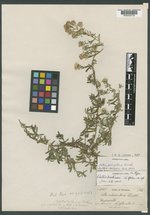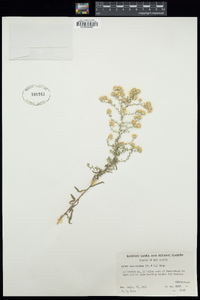
|
|
|
|
Family: Asteraceae
Rough White Prairie American-Aster, more...white prairie aster
[Aster falcatus Lindl., moreAster falcatus subsp. falcatus] |
Perennials 10-80 cm (colonial or cespitose, eglandular; with branched rhizomes or with ± cormoid, branched, woody caudices. Stems 1-5+, ascending to erect (grayish brown to brown), moderately to densely hairy. Leaves (light grayish green) firm, margins entire, strigose, apices ± spine-tipped; basal withering by flowering, sessile, blades oblanceolate, 10-40 × 3-10 mm, bases attenuate, margins usually entire, rarely remotely serrate, scabrous, apices acute to obtuse, rounded to mucronulate-spinose, faces glabrate to moderately strigose; proximal cauline sessile, blades linear oblanceolate to oblong, 10-40(-60) × 1.5-4(-7) mm, reduced distally, bases cuneate, margins entire, coarsely ciliate, apices acute or obtuse, faces sparsely to densely appressed hispido-strigose; distal sessile, blades linear-oblong to linear-lanceolate, 25-45 × 2-3 mm, bases cuneate, margins entire, apices acute, faces moderately to densely strigose. Heads [(1-)10-200+] in racemiform to diffuse-paniculiform arrays (1-10+ per branch, usually not crowded). Peduncles 0.2-4 cm, densely hairy, bracts 1-3+, linear to lanceolate, densely hairy. Involucres campanulate, (4.5-)5-8 mm. Phyllaries in 3-4 series, outer oblanceolate to spatulate (1.5-2 mm), inner linear-lanceolate (3-4 mm), unequal, bases (whitish to tan) ± indurate in basal 1 / 2 - 3 / 4 , margins hyaline, scabrous proximally, green zones diamond-shaped, in distal 1 / 4 - 1 / 2 , apices (outer) acute to obtuse, clear spine-tipped, spreading to reflexed, (inner) acuminate to attenuate, faces sparsely to moderately hispid-strigose. Ray florets (15-)20-35; corollas usually white, sometimes blue or pink, laminae (8-)18-30 × 1.1-1.4 mm. Disc florets (8-)18-30; corollas yellow becoming brown, 2-2.5 mm, lobes triangular, 0.7-1.2 mm, glabrous. Cypselae dark brown, obovoid, not compressed, 2-2.5 mm, faint-nerved, faces densely strigose; pappi whitish, 4.5-6 mm. Symphyotrichum falcatum is introduced in Ontario and Illinois. It may closely resemble S. ericoides, which has smaller heads with fewer florets in denser arrays. The two can be difficult to distinguish on the Great Plains. A. G. Jones (1978) recognized two subspecies of S. falcatum, one with two varieties. Those two subspecies are treated as varieties here.
Duration: Perennial Nativity: Native Lifeform: Forb/Herb General: Perennial, 10-80 cm tall, colonial or tufted; stems 1-5 or more, ascending to erect, moderately to densely pubescent; plants bearing branched rhizomes or branched woody caudices. Leaves: Basal (often withered by flowering) and cauline, alternate, with clusters of smaller leaves arising in the axils of the primary leaves, oblanceolate or linear to oblong, 1-4 cm long, 1.5-10 mm wide, reduced upwards, light grayish green, nearly glabrous to strigose, margins usually entire, rarely toothed; often tipped with a minute spine; blades sessile. Flowers: Heads borne in dense, compact clusters; involucre cylindric, 5-6 mm long, 2-3 mm wide; phyllaries mostly 5 in 1 series, glandular, sparsely villous, the tips acute to acuminate; disk flowers only, mostly 5, white to pink, fragrant; flowers July-October. Fruits: Achene, obovoid, 2-2.5 mm long, faintly veined, dark brown, densely strigose; pappus of 25-40 minutely barbed bristles, 4.5-6 mm long, whitish. Ecology: Dry, open sites, mountain slopes, ponderosa pine forests, streambanks, roadsides, disturbed habitats; 1100-2400 m (3500-8000 ft); Apache, Cochise, Coconino, Gila, Greenlee, Maricopa, Navajo, Pima, Santa Cruz, and Yavapai counties; western Canada, central Notes: Two varieties occur in our region and are distinguished as follows: plants of var. commutatum are colonial, densely pubescent, rhizomatous, usually bearing 1 stem, peduncles are stout, phyllaries are somewhat unequal, the tips are strongly recurved to spreading; plants of var. falcatum are tufted, sparsely strigose, with corm-like caudices, and with 1-5 or more stems, peduncles are long and slender, phyllaries are nearly equal, the tips not strongly recurved or spreading. Symphyotrichum ericoides (white heath aster) [=Aster ericoides] is a perennial, 20-80 cm tall, tufted or colony-forming, with 1 to few, erect to ascending stems; basal leaves are oblanceolate, oblong, or spatulate, 1-5 cm long, cauline blades are similar, reduced; leaves bear a white spine at the tips; heads are 1 to numerous, arranged in panicle-like arrays; ray flowers are mostly 10-18, white, or seldom pink to bluish; disk flowers are 6-12 or more, yellow. It occurs in disturbed sites, along roadsides, and in gravelly to sandy soils. Two varieties occur in North America: var. ericoides and var. pansum, both of which are reported to occur in Arizona. Symphyotrichum ascendens (western aster) [=Aster adscendens] is similar to S. falcatum but may be distinguished by more distinctly oblanceolate leaves without spine tips, and fewer flower heads with ray flowers blue, violet, or pink. It can occur in similar habitats as S. falcatum, but often prefers slightly moister or higher elevation meadows. The vegetative form of S. ascendens is often confused with Dieteria canescens. Symphyotrichum lanceolatum (white panicled aster) is a perennial, mostly 30-150 cm tall, colony forming, with solitary stems. Leaves are linear- lanceolate or linear-oblanceolate, 1-8 cm long, the margins of the lower cauline blades shallowly serrate, the upper cauline blades entire. Heads are 1 to numerous, arranged in panicle-like arrays and subtended by large leafy bracts. Ray flowers are 18-45, pale to dark blue. Disk flowers are mostly 18-52, yellow. Ours, as here described, is var. hesperium. It typically occurs in coniferous forests, in meadows, and along roadsides and streams. Symphyotrichum falcatum may be propagated by seed or by cuttings treated with rooting hormones. The Zuni report that blossoms, mixed with yucca suds, help hair to grow, especially in infants. Synonyms: Aster falcatus, Lasallea falcata, Virgulus falcatus Editor: Springer et al. 2008 Similar to no. 20 [Aster ericoides L.], but smaller, seldom over 6 dm, with fewer and larger heads; heads solitary or clustered at the ends of the not at all secund branches, or the stem scarcely branched and the infl subracemiform; invol 5-7 mm, its bracts seldom much imbricate, the outer often acute as well as the inner; rays 20-35, 4-8 mm; disk-fls (14-)18-30; 2n=10, 20, 30. Prairies and other open places; Mack., Yukon, and e. Alas. s. to w. Minn., Io., Tex. and Ariz. Typical A. falcatus is northern, tufted, and not rhizomatous. More or less rhizomatous plants, commoner with us, have been segregated as var. commutatus (Torr. & A. Gray) A. G. Jones. (A. commutatus) Gleason, Henry A. & Cronquist, Arthur J. 1991. Manual of vascular plants of northeastern United States and adjacent Canada. lxxv + 910 pp. ©The New York Botanical Garden. All rights reserved. Used by permission. |
|
|
|
This project was made possible in part by the Institute of Museum and Library Services [MG-70-19-0057-19].
Powered by Symbiota

